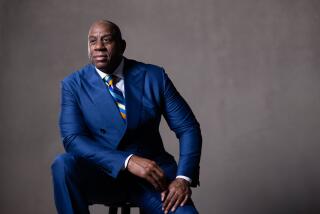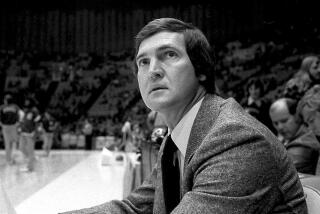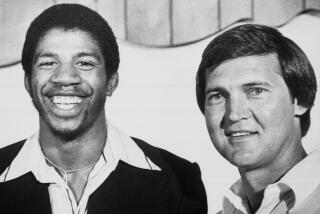It Wasn’t Always Magic for NBA
Earvin Johnson planted himself firmly in a bulkhead seat on the left side of the DC-10 headed from Los Angeles to Philadelphia, flashed his trademark smile, and announced, “Never fear, E.J. is here.”
His Laker teammates, however, had plenty to fear. Although they enjoyed a 3-2 lead in the NBA finals in that spring of 1980, they were headed for the home court of the Philadelphia 76ers without their dominating center, Kareem Abdul-Jabbar, who was staying home because of a badly sprained ankle.
Johnson had symbolically sat in the seat normally reserved for Abdul-Jabbar and he planned to take Abdul-Jabbar’s place on the court as well, playing center for at least part of the game.
Johnson, a 20-year-old rookie at the time, wound up playing all five positions at various points in the game, scoring 42 points, making all 14 of his free throws, getting 15 rebounds and handing out seven assists as he led the Lakers to a 123-107 victory and the first of five NBA titles they would win with the ball in his talented hands.
E.J. was truly there, in Philadelphia’s Spectrum and in the homes of viewers in Philadelphia and L.A.
But he wasn’t seen elsewhere until much later.
One of the most memorable games in the history of the NBA finals was shown on tape-delay everywhere but in the competing cities.
It may be hard to believe now, when the NBA is enjoying unprecedented popularity, when Michael Jordan’s face is as recognizable as Bill Clinton’s, when every minute of the 1997 NBA finals will be seen and replayed via satellite signals bounced around the globe, but once upon a time, NBA fans in most cities couldn’t see the prime games of their sport live.
And that time was less than two decades ago.
At the start of the 1980s, the NBA was in deep trouble. Bill Russell and Wilt Chamberlain, the giants who had made pro basketball a bona fide sport, were gone. So were Jerry West, Elgin Baylor, Oscar Robertson and most of the other marquee names that had drawn the media and the fans.
In 1978, the Washington Bullets won the NBA title. Their biggest names were Wes Unseld and Elvin Hayes. The following year, the Seattle Supersonics were champions. They were led by Jack Sikma, Dennis Johnson and Gus Williams.
Hardly the stuff of legends.
CBS, then the league’s network, didn’t want this poor cousin of football and baseball to gum up its sweeps period. CBS executives didn’t even want the NBA in prime time. Instead, they taped the weekday games of the finals and showed them at 11:30 p.m., when they figured they were going to get blown out in the ratings anyway by NBC’s Johnny Carson, then the undisputed king of late-night television.
It was unheard of in those days for a Laker playoff game to get a higher rating than a Dodger spring training game.
If your city’s team was in the NBA finals, it was a big deal. But otherwise, you were part of a small, hard-core group of fans who curled up on the couch in pajamas to watch a game played hours earlier, a game whose score had been desperately avoided.
That all changed, of course, with the arrival of the 1979-80 season, which coincided with the arrival of not only the talented, charismatic Johnson, but also his fellow superstar on the other side of the country, Larry Bird.
It didn’t turn around immediately. Even several years after Johnson and Bird had hit the scene, the financial situation in some NBA cities was bleak. The Utah Jazz, for instance, was seriously talking about finding another team to merge with so it could stay afloat.
Instead, the Jazz, thanks to the revival sparked by Johnson and Bird, is floating higher than ever today as it prepares to take on the Chicago Bulls in the NBA finals.
There were factors other than Johnson and Bird that led to the league’s blossoming:
* A merger with the American Basketball Assn. in 1976 had brought over such stars as Julius Erving, George Gervin and Dan Issel;
* The appointment of David Stern as NBA commissioner resulted in a salary-cap system that finally brought financial stability;
* And an innovative marketing and merchandising program, coupled with new technology in television that effectively showcased the brilliant athletic talent of the NBA’s stars, appealed to a new generation of fans.
The result was a league that was suddenly being wined and dined by the networks and cable systems alike.
Tape-delay? Who would dare make such an outlandish suggestion today?
Only somebody who has been in a coma since 1980.
More to Read
Go beyond the scoreboard
Get the latest on L.A.'s teams in the daily Sports Report newsletter.
You may occasionally receive promotional content from the Los Angeles Times.










